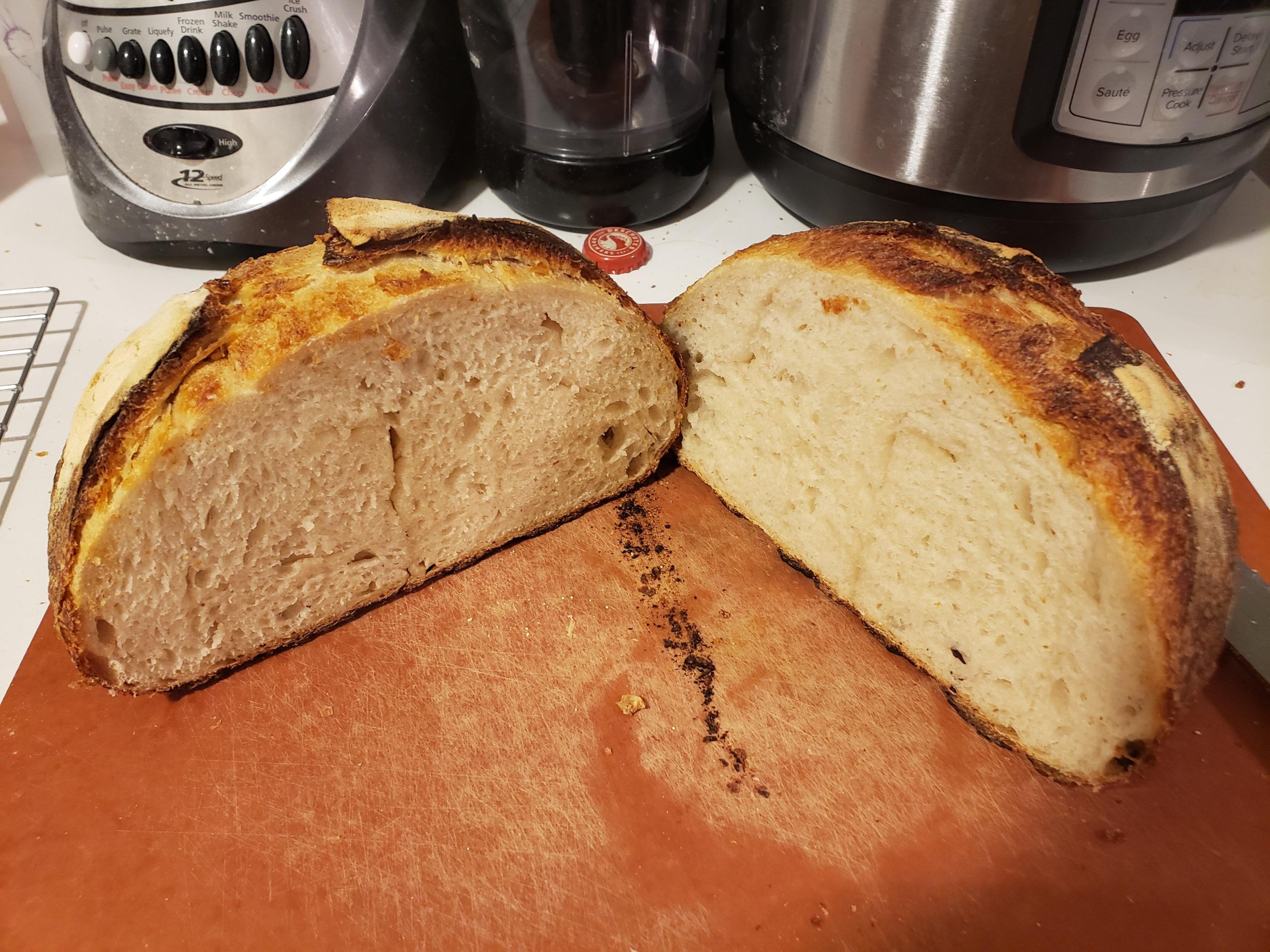Learn how to make sourdough at home. This beginners’ sourdough tutorial will take you step-by-step through the entire process.
This sourdough recipe is ready to go in just 10 minutes!
What Is Sourdough Bread?
Sourdough is a naturally leavened bread made with a sourdough starter.
To make the bread rise, instead of commercial yeast, you can use a live culture fermented, also known as a starter.
The starter breaks down gluten in the dough, resulting in a more digestible bread. You get healthier bread that tastes better than any you can buy in a store or bakery.
The sourdough crust is a favorite for its thick, chewy texture and slightly sour taste.
Lactobacillus, and acetobacillus are two gut-friendly bacteria found in the starter of sourdough. These bacteria are responsible for fermenting the sugars in the dough.
Sourdough Starter
You’ll need to make a starter before you can bake your first loaf.
A starter is created by mixing flour with water in a jar. Wild yeasts and bacteria in the environment feed on the flour. This causes the yeast and bacteria within the mixture to multiply.
The starter will grow stronger with regular feedings and eventually can be used to make sourdough.
It can take anywhere between 7-14 days to build a new starter, depending on your kitchen’s temperature.
How To Feed Your Starter For This Recipe
When feeding, I use a small amount of sourdough to water and flour ratio so that the dough will rise slowly for several hours.
You can also feed the starter in the evening, mix the dough the next morning and bake the bread the same night. You can also feed the starter the night before, then mix the dough in the morning and bake the bread the next morning. This recipe is so easy to work into your schedule.
Mix 10 grams of starter that has not been fed with 25 grams flour, and 25 grams water in a clean, jar. Cover it loosely, and let it rise until room temperature.
When Is My Starter Ready To Use?
When the starter has doubled in size, and bubbles are visible on the jar’s surface and the sides, you’ll be able to use it.
This takes 12 hours in my kitchen at 68degF (20degC). It will take more time to ferment in cooler kitchens, and less time in warmer kitchens.
You can use a test to determine if your starter is ready. Drop a little starter into a water glass. It’s ready for baking if it floats. If it sinks, feed it again and try it again.
It may take several feedings for a sourdough starter to reach the strength needed to be used in baking.
Ingredients Needed
The beauty of sourdough is that it only requires a few ingredients.
- bread wheat
- water
- salt
- sourdough starter
If possible, we recommend organic flour because it’s free of bleach, bromate, and glyshophate. However, any type and price range of bread flour is fine to use.
Bread flour in the U.S. is a white flour that has a high percentage of protein. I prefer a bread flour that has a protein content of between 11.7% and 12.7%.
How To Make Easy Sourdough Bread: Step-by-step Instructions
Let’s look at the steps that you will follow to make a basic loaf.
- Feed the sourdough starter, and allow it to rise until it doubles in size.
- Let the dough rest at room temperature for an hour after mixing.
- Two sets of stretching and folding should be performed 30 minutes apart.
- Cover the bowl with a towel and let it ferment on the counter for 7-10 hours.
- Let the dough rise for 1 to 2 hours.
- Score and bake
Step 1: Feeding the sourdough starter
Add the flour to a clean jar 12 hours prior to mixing.
- 10 grams unfed starter
- 25 g water
- 25 Grams Flour
Cover the jar with a loose cover and let it rest at room temperature.
The temperature in your kitchen will determine how long it takes for this small amount of unfed starter to double.
Step 2: Method of mixing the dough
Transfer the starter to a large dish along with 350 grams water once it has doubled.
Stirring the two with a stiff spatula will distribute the starter in the water evenly.
Add 500 grams of flour and 10 g of salt to the bowl.
Work the ingredients with your hands or a spatula until they form a shaggy mixture.
Work any dried bits that have stuck to the bowl sides into the dough.
This is a low-hydration dough that’s easy to work with for beginners.
Cover the bowl using a silicone bowl lid, a beeswax towel or a moist kitchen towel. Let the dough rest on the counter for an hour.
The resting period can also be called “autolyse”. The dough will absorb water during this time, making it easier for you to work with.
Step 3: Stretch and fold the dough
After an hour, do two sets of stretching and folding the dough 30 minutes apart.
This will help to develop gluten and add strength to your dough.
To prevent your hands from sticking, wet them with water. Take the dough and fold it over on itself.
Repeat this step, turning the bowl in a quarter-turn. (4) The dough will start to form a tight ball.
Repeat the stretching and folding process after 30 minutes.
Step 4: Bulk fermentation
Cover the bowl after the second stretch and fold and let the dough sit on the counter for 7-10 hours.
How long does it take for the sun to rise?
When the dough has grown by 50-75%, it is ready to move on.
This takes 7-8 hours in my kitchen at 68degF.
Check your kitchen after 3-4 hours if it is warm to ensure it hasn’t been over-proofed.
Step 5: Surfaces and second rise
Turn the dough gently onto a lightly-floured surface.
How to make a round sourdough ball
Form the dough into a round by pulling the four sides up into the center.
Turn the dough so that the seam side is facing down.
Gently cup and pull the dough until a skin is formed on the outside.
The seam side should be down. Use the parchment as a sling and lift the dough into the bowl.
Cover the bowl, and let the dough rest for 1 to 2 hours.
When is the dough ready to be baked?
It is ready to use when the dough has risen about 25%.
If you’re still not sure, make an indentation about half an inch deep with your thumb. The dough is ready for baking if the indentation springs back slowly.
It still needs time to rise if the indentation springs all the back or almost.
Over-proofing is likely to be the cause of an indention that doesn’t spring back at all.
Step 6: Preheat the oven with a dutch oven inside
With an empty Dutch oven inside, pre-heat your oven at 450degF before you bake the dough.
What is the best way to bake sourdough?
I use a 5-quart Dutch oven to bake sourdough.
The dutch oven works like a steam oven commercial by trapping steam during the first 20 minute of baking.
This steam will help to give the bread a good “oven rise” or rise.
Step 7: Score and bake
Use a bread lame, or a razor blade with a sharp edge to cut a slash of 2-3 inches on the top surface of the dough.
Scoring allows the dough rise and expand upwards, instead of breaking at the weakest part.
Remove the Dutch oven from the oven while wearing heavy silicone gloves.
Use the parchment paper to lift the dough out of the bowl. Then, transfer it into the Dutch oven.
The parchment paper will prevent the dough from sticking on the bottom of the Dutch oven.
Put the lid on the Dutch oven and return it to the heat. Bake for 20 minutes.
Remove the lid, and continue baking uncovered until the crust turns golden brown.
Allow the bread to cool for 1 to 2 hours on a cooling rack before cutting it. This will prevent it from becoming sticky.


